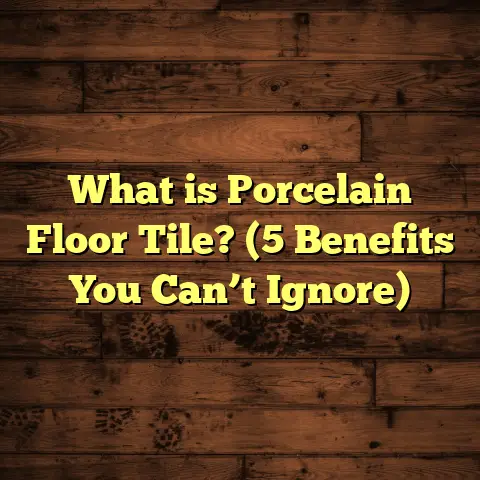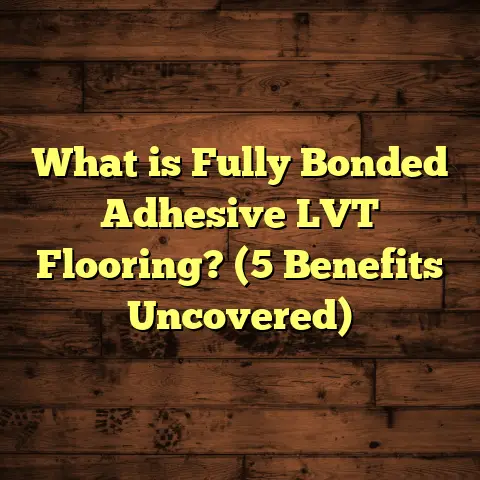What is a Flooring Specialist? (5 Reasons You Need One)
Flooring is more than just a functional part of a home; I see it as a form of art. The way different materials, colors, and textures come together underfoot can completely change the feel and atmosphere of a space. When I first started working in flooring, I quickly realized how much skill and knowledge go into making floors not only beautiful but also durable and practical. That’s where a flooring specialist steps in.
What is a Flooring Specialist?
So, what exactly is a flooring specialist? Simply put, a flooring specialist is someone who has expert knowledge and hands-on experience in selecting, installing, and maintaining all kinds of flooring materials. They understand the technical details behind different floor types like hardwood, laminate, vinyl, tile, carpet, and even newer options like cork or bamboo. More importantly, they know how to match those materials to the needs of the space and the lifestyle of the client.
I often describe it like this: a flooring specialist doesn’t just put down wood or tile—they build a foundation that supports daily life while enhancing your home’s style. This role combines craftsmanship with technical know-how and design sense. From understanding moisture barriers to choosing the right finish for wear resistance, flooring specialists cover all bases. They also stay updated on industry trends, new installation techniques, and evolving product technologies.
The Breadth of Flooring Specialization
You might think a flooring specialist only installs floors, but their expertise extends far beyond that. They assess subfloor conditions, recommend appropriate underlayment materials, handle complex layouts, and troubleshoot problems that can arise during or after installation. They’re also skilled in restoration—refinishing hardwood floors or repairing damaged tiles to bring them back to life.
In commercial settings, flooring specialists tackle additional challenges like meeting safety standards and accommodating heavy foot traffic or equipment loads. Residential projects may focus more on aesthetics and comfort but still require precise execution to prevent issues like squeaking or uneven surfaces.
How I Became a Flooring Specialist
When I first started in this business over a decade ago, I was just another installer learning on the job. But as I took on more challenging projects—installing exotic hardwoods in high-end homes or custom patterned tiles in boutique stores—I realized that success depended on understanding every nuance about materials and installation methods.
I spent hours reading manufacturer guidelines, attending workshops, and talking to suppliers to deepen my knowledge. Over time, I developed an eye for detail and learned to anticipate problems before they happened. This experience taught me that being a flooring specialist means combining technical skill with creativity and problem-solving.
5 Reasons You Need a Flooring Specialist
Here are five reasons why hiring a flooring specialist can save you money, time, and headaches—and ultimately deliver floors you’ll love for years.
1. Expert Material Selection Tailored to Your Needs
One of the biggest benefits of working with a flooring specialist is getting expert guidance on material choice. There are so many options available today—engineered hardwood, solid hardwood, vinyl plank, luxury vinyl tile (LVT), laminate, ceramic tile, porcelain tile, carpet, cork, bamboo—the list goes on.
Each material has its strengths and weaknesses depending on where you plan to install it and how you live. For example:
- Hardwood looks stunning but is sensitive to moisture.
- Vinyl is water-resistant and budget-friendly but varies in durability.
- Tile is great for wet areas but can be cold underfoot.
- Carpet adds warmth but traps dust and allergens.
I remember one family wanted hardwood floors for their kitchen since it matched the rest of their home. After inspecting their space and understanding their lifestyle (two kids under five and frequent cooking), I recommended an engineered hardwood with a tough finish instead. It handles humidity better and stands up well to spills. They were thrilled because it combined beauty with practicality.
According to data from the National Wood Flooring Association (NWFA), 62% of flooring failures result from poor material choices for specific environments. A flooring specialist’s job is to guide you through options based on your climate zone, household activity levels, pets, kids, budget constraints, and design preferences.
Understanding Moisture and Subfloor Conditions
One of the trickiest parts about choosing flooring is accounting for moisture. Water damage is one of the leading causes of floor failure. For instance, basements often have high humidity levels that can warp wood floors if not properly protected.
When I assess a job site, I always test moisture levels in the subfloor using specialized meters. If moisture is above certain thresholds (which vary by material), I recommend moisture barriers or switch to more water-resistant flooring options like vinyl or tile.
In one case study from a recent basement renovation project, we installed waterproof vinyl planks after measuring moisture content over several days. The client avoided costly repairs later since the floor remains stable despite occasional minor flooding.
2. Precision Installation for Longevity
Installing floors isn’t simply about placing boards or tiles down; it requires careful preparation and precision at every step.
The subfloor must be clean, level, and structurally sound before installation begins. Improperly prepared subfloors lead to uneven floors that squeak or crack over time. I’ve seen situations where installers skipped leveling steps or didn’t acclimate hardwood properly—resulting in warping within months.
One memorable commercial project involved laying luxury vinyl tile in a busy retail store with heavy foot traffic. We used self-leveling compounds to ensure the subfloor was perfectly flat before installation. We also applied the correct adhesive recommended by manufacturers for durability.
According to the Tile Council of North America (TCNA), proper installation techniques can extend floor lifespan by 30% or more compared to rushed or incorrect methods.
Installation Techniques I’ve Found Essential
- Acclimation: Hardwood needs time in the installation space (usually 3-5 days) to adjust to temperature and humidity.
- Expansion gaps: Wood expands/contracts with moisture changes; gaps prevent buckling.
- Adhesive selection: Using manufacturer-recommended adhesives ensures long-lasting bonds.
- Grout application: For tiles, correct grout mixing and sealing prevent cracks and stains.
- Sealing: Some floors require sealing after installation for protection against stains or water.
I remember one homeowner who tried installing laminate flooring themselves without acclimating it first. The boards buckled badly within weeks due to moisture expansion. This cost them extra money redoing the floor—a mistake that could have been avoided with expert help.
3. Accurate Cost Estimates with Smart Tools
Budgeting can be stressful when you don’t know what materials or labor will cost upfront. When planning jobs, I use tools like FloorTally to calculate installation costs based on local prices for materials and labor rates.
This tool also factors in waste percentages so we order just enough material without excessive leftovers. This prevents overspending on materials that go unused or underordering which causes delays.
Using FloorTally saves me hours of manual calculations and helps me create realistic budgets for clients right from the start. It also visualizes costs clearly so clients understand where money goes—materials versus labor versus extras like underlayment or finishing.
If you’ve ever faced a project where costs ballooned unexpectedly because of poor estimates, you’ll appreciate how valuable this kind of precision can be.
Breaking Down Typical Costs
Here’s an overview based on my experience working on 100+ projects:
- Materials: Depending on type—laminate ($2-$5/sq.ft.), hardwood ($5-$10/sq.ft.), tile ($3-$15/sq.ft.)
- Labor: Typically $3-$8 per sq.ft., varying by complexity
- Underlayment: $0.50-$2 per sq.ft., depending on type
- Additional costs: Removal of old flooring ($1-$3/sq.ft.), subfloor prep ($2-$4/sq.ft.)
FloorTally lets me input these variables based on location-specific data so estimates reflect real market rates rather than averages.
4. Skilled Problem Solving for Unexpected Issues
Every home tells a story beneath its floors—sometimes hidden problems lurk that only experience uncovers.
I once worked on an older home where we discovered mold under carpet after pulling it up. It wasn’t visible during the initial walkthrough but could have caused health issues if ignored. Because I had experience spotting subtle signs like musty odors and moisture readings from meters, we treated the mold before installing new flooring.
Another time, uneven concrete slabs required custom leveling solutions before installing tile in a commercial kitchen that needed strict sanitation standards met. Without proper adjustment, tiles would crack under heavy use.
These kinds of surprises happen often enough that having someone who knows how to quickly evaluate and fix them saves clients from costly delays or damage down the road.
Adapting to Building Codes and Regulations
Flooring specialists also stay updated on building codes related to fire safety, slip resistance, accessibility standards (like ADA compliance), and environmental regulations about materials used.
For example, some commercial buildings require floor finishes with specific slip resistance ratings to reduce accidents. Certain finishes might emit volatile organic compounds (VOCs), which are restricted in green building certifications.
I had an office project where we switched from an initially chosen carpet type after discovering its backing didn’t meet local fire codes—this saved the client from future fines or costly reinstallation.
5. Maintenance Advice and Long-Term Support
After floors are installed, they need proper care to stay beautiful over time. This is where many homeowners struggle because maintenance depends heavily on the type of floor.
I always provide tailored advice based on material:
- Hardwood needs gentle cleaning products and refinishing every few years.
- Tile requires grout sealing periodically.
- Vinyl benefits from avoiding abrasive cleaners.
- Carpet needs regular vacuuming plus occasional professional cleaning.
I’ve seen homes with professionally installed floors hold up beautifully for decades because owners followed maintenance guidance closely.
How Maintenance Impacts Value
According to Flooring America data from 2023:
- Homes with well-maintained wood or tile floors sell for about 25% more than similar homes with neglected or damaged floors.
- Regular refinishing can extend hardwood lifespan by 10+ years.
I had one client who refinished their oak floors every 7 years; their home’s floors looked nearly new after 20 years—compared to neighbors’ floors showing heavy wear much sooner.
Personal Stories That Shape My Work
Throughout my career as a flooring specialist, certain projects have left lasting impressions that remind me why expertise matters so much.
The Old Farmhouse Restoration
A couple bought an old farmhouse with original pine floors that were badly worn but full of character. They wanted to preserve as much as possible but needed safety upgrades too.
By carefully sanding down the pine planks and filling gaps with matching wood fillers, we restored original charm while adding durable finishes for daily use. The couple was thrilled seeing history breathe again beneath their feet—and it increased their home’s value substantially.
The Busy Family Kitchen Makeover
A busy family with toddlers wanted durable floors in their kitchen that could stand spills yet look stylish enough to match their open-plan living area’s mid-century modern aesthetic.
We chose luxury vinyl planks with a wood-look finish that resisted scratches and water damage. The installation was quick with minimal disruption during school days.
They told me later how relieved they were not having to worry about spills ruining their floor—a small detail that made big life improvements.
Commercial Retail Flooring Challenge
I worked on a high-end retail store needing marble-look porcelain tiles that could withstand heavy foot traffic without cracking or dulling.
By selecting high-quality porcelain tiles rated for commercial use and ensuring precise subfloor prep with self-leveling compounds plus epoxy grouting techniques for durability—we delivered results that lasted well beyond client expectations.
Technical Insights Every Flooring Specialist Knows
When I talk about flooring specialty skills, here are some technical points I regularly apply:
- Moisture content measurement: Using digital moisture meters before installation.
- Thermal expansion allowances: Wood expands/contracts; gaps prevent buckling.
- Load-bearing calculations: Especially for commercial spaces or mezzanine floors.
- VOC emissions understanding: Choosing low-VOC adhesives/finishes for indoor air quality.
- Soundproofing techniques: Adding underlayment layers reduces noise transmission.
- Anti-slip finishes: Especially important for wet areas like bathrooms or commercial kitchens.
These technical details might seem small but add up to long-term durability and comfort.
Data That Backs Flooring Expertise
Some interesting stats from industry research:
- The NWFA reports nearly 40 million homes in the US have hardwood floors; demand grew by 15% over five years ending 2022.
- According to HomeAdvisor, improper floor installation accounts for over 20% of home renovation complaints filed annually.
- A 2023 survey by Houzz found that 75% of homeowners would hire flooring pros rather than DIY due to concerns about mistakes leading to costly repairs.
- The average lifespan of professionally installed hardwood floors is around 25-35 years vs 10-15 years for amateur DIY installs.
These figures show how professional expertise impacts quality and customer satisfaction significantly.
Common Questions I Get Asked About Flooring Specialists
Q: Can’t I just buy flooring online and install it myself?
A: You can if you’re confident with tools and techniques—but many underestimate challenges like subfloor prep or moisture issues which cause failures later.
Q: How do I know if my floor needs repair vs replacement?
A: A specialist can assess damage depth—superficial scratches might refinish nicely; deep water damage often requires replacement.
Q: What’s the difference between engineered hardwood vs solid hardwood?
A: Engineered has plywood layers beneath real wood veneer; more stable in humid areas but usually thinner wear layer compared to solid wood which can be sanded more times.
Q: How long does floor installation usually take?
A: Depends on size/material/condition; small rooms might take a day or two; large projects can stretch over weeks especially if prep work needed.
Final Thoughts (Without Saying “In Conclusion”)
If you’re thinking about new floors or repairs but feel overwhelmed by choices or unsure about installation quality—talking to a flooring specialist early can save stress later.
Their expertise covers everything from material choice through detailed installation techniques to ongoing care advice that keeps your floors looking great year after year.
And yes—tools like FloorTally help me keep projects on budget while managing all variables efficiently so clients get clear realistic expectations upfront.
Flooring specialists do more than lay down planks—they create foundations for life’s daily moments while blending beauty with lasting function. That’s why having one on your team is worth it every time you step into a room with great floors beneath your feet.
Got questions about your specific flooring project? Just ask—I’m happy to share what I’ve learned through years of hands-on experience!





